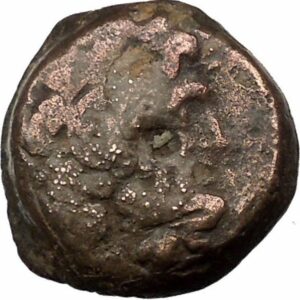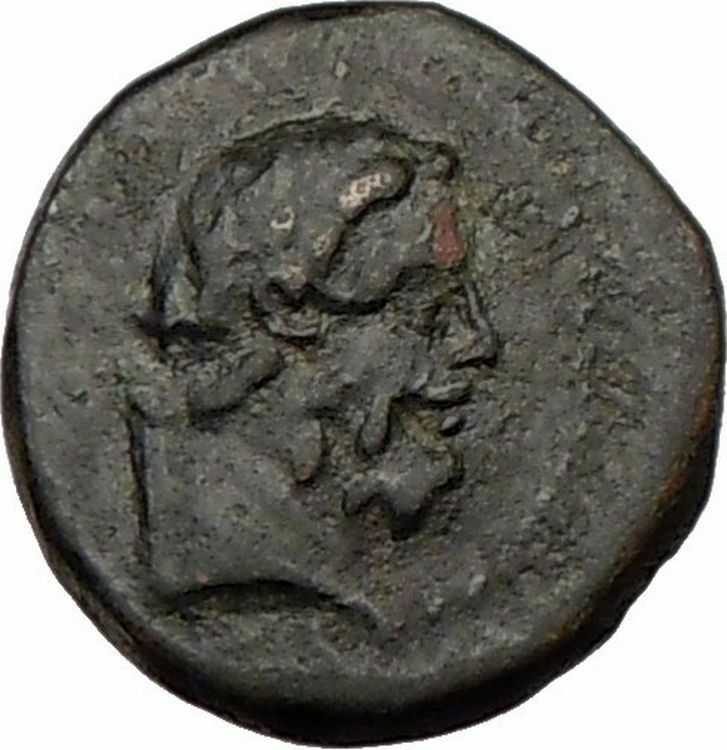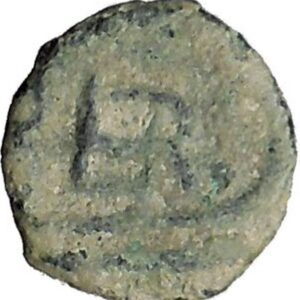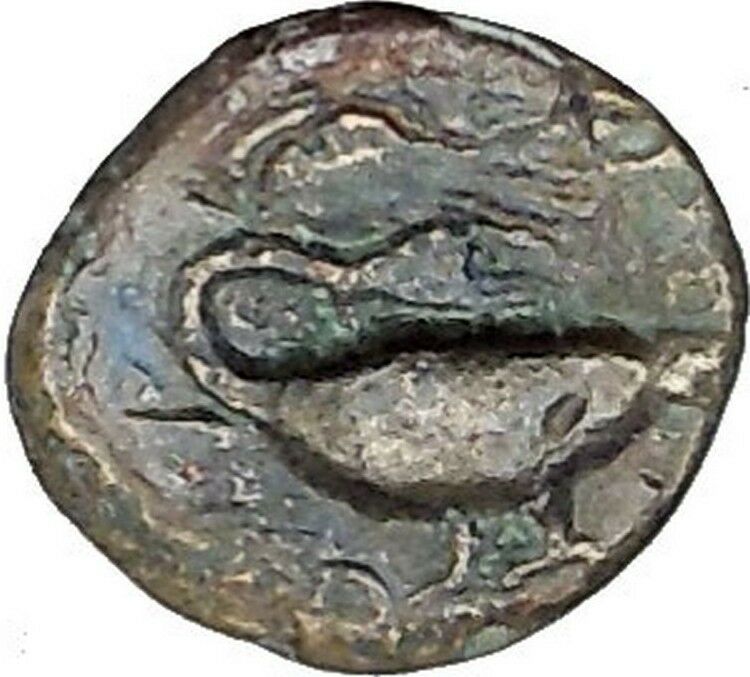|
Greek city of
Odessos in
Thrace
Bronze 12mm (1.90 grams) Struck circa 281-188 B.C.
Reference: Sear 1680
Laureate head of
Apollo
right.
OΔHΣITΩN, The Great God Derzelas
reclining left, holding phiale and cornucopia, thyrsos
before; above, monogram.
Odessos was a colony of Miletus.
You are bidding on the exact item pictured,
provided with a Certificate of Authenticity and Lifetime Guarantee of
Authenticity.
In
Greek mythology
, a thyrsus or thyrsos
(Greek:
θύρσος
) was a staff of
giant fennel
(Ferula communis) covered
with ivy
vines and leaves, sometimes wound with
taeniae
and always topped with a
pine
cone
. These staffs were carried by
Dionysus
and his followers.
Euripides
wrote that
honey
dripped from the thyrsos staves that the
Bacchic
maenads
carried.The thyrsus was a sacred
instrument at religious rituals and
fêtes.
Symbolism
The thyrsus, associated with
Dionysus
(or Bacchus) and his followers, the
Satyrs
and
Maenads
, is a symbol of
prosperity
,
fertility
,
hedonism
, and pleasure/enjoyment in general. It
has been suggested that this was specifically a fertility
phallus
, with the fennel representing the shaft
of the penis and the pine cone representing the “seed” issuing forth. The
thyrsus was tossed in the Bacchic dance:
Pentheus: The thyrsus— in my right hand shall I hold it?
-
- Or thus am I more like a Bacchanal?
Dionysus: In thy right hand, and with thy right foot raise it”
Sometimes the thyrsus was displayed in conjunction with a
kantharos
wine cup, another symbol of Dionysus,
forming a male-and-female combination like that of the royal scepter and orb.
Literature
In the Iliad
,
Diomedes
, one of the leading warriors of the
Achaeans
, mentions the thyrsus while speaking
to
Glaucus
, one of the
Lycian
commanders in the
Trojan army, about
Lycurgus
, the king of
Scyros
:
He it was that/drove the nursing women who were in charge/of frenzied
Bacchus through the land of Nysa,/and they flung their thyrsi on the ground
as/murderous Lycurgus beat them with his ox-/goad. (Iliad, Book
VI.132-37)
The thyrsus is explicitly attributed to Dionysus in
Euripides
‘s play
The Bacchae
as part of the costume of the
Dionysian cult.
…To raise my Bacchic shout, and clothe all who respond/ In fawnskin
habits, and put my thyrsus in their hands–/ The weapon wreathed with
ivy-shoots…” Euripides also writes, “There’s a brute wildness in the
fennel-wands—Reverence it well.” (The Bacchae and Other Plays, trans.
by Philip Vellacott, Penguin, 1954.)
Socrates
writes in
Phaedo
:
I conceive that the founders of the mysteries had a real meaning and were
not mere triflers when they intimated in a figure long ago that he who
passes unsanctified and uninitiated into the world below will live in a
slough, but that he who arrives there after initiation and purification will
dwell with the gods. For “many,” as they say in the mysteries, “are the
thyrsus bearers, but few are the mystics,”–meaning, as I interpret the
words, the true philosophers.
In Part II of
Johann Wolfgang von Goethe
‘s
Faust
,
Mephistopheles
tries to catch a
Lamia
, only to find out that she is an
illusion:
Well, then, a tall one I will catch…/And now a thyrsus-pole I
snatch!/Only a pine-cone as its head. (7775-7777)
Sookie Stackhouse notes the thyrsus carried by the maenad in the 2nd book of
The Southern Vampire Mysteries
.
She idly waved the long wand with the tuft on the end. It was called a
thyrsis [sic];
I’d looked maenad up in the encyclopedia. Now I could die educated. (Harris,
Charlaine (2006-09-01). “Living Dead in Dallas: A Sookie Stackhouse Novel”}
Gallery
-
A Bacchant holding a thyrsus: Malice, by
William-Adolphe Bouguereau
, 1899
-
Roman relief showing a Maenad holding a thyrsus (Prado,
Madrid
).
-
Bacchus Triumphant (1882)
by
John Reinhard Weguelin
-
A Maenad uses her thrysos to ward off a Satyr,
Attic red-figure
kylix
, circa 480 BC

In
Greek
and
Roman mythology
, Apollo
,
is one of the most important and diverse of the
Olympian deities
. The ideal of the
kouros
(a
beardless youth), Apollo has been variously recognized as a god of light and the
sun; truth and prophecy;
archery
;
medicine and healing; music, poetry, and the arts; and more. Apollo is the son
of Zeus
and
Leto, and has a
twin
sister, the chaste huntress
Artemis
.
Apollo is known in Greek-influenced
Etruscan mythology
as Apulu. Apollo was worshiped in both
ancient Greek
and
Roman religion
, as well as in the modern
Greco
–Roman
Neopaganism
.
As the patron of Delphi
(Pythian Apollo), Apollo was an
oracular
god — the prophetic deity of the
Delphic Oracle
.
Medicine and healing were associated with Apollo, whether through the god
himself or mediated through his son
Asclepius
,
yet Apollo was also seen as a god who could bring ill-health and deadly
plague
as well as one who had the ability to cure. Amongst the god’s
custodial charges, Apollo became associated with dominion over
colonists
, and as the patron defender of herds and flocks. As the leader of
the Muses
(Apollon
Musagetes) and director of their choir, Apollo functioned as the patron god
of music and poetry
.
Hermes
created
the lyre
for him,
and the instrument became a common
attribute
of Apollo. Hymns sung to Apollo were called
paeans
.
In Hellenistic times, especially during the third century BCE, as Apollo
Helios he became identified among Greeks with
Helios
,
god of
the sun
, and his sister Artemis similarly equated with
Selene
,
goddess
of the moon
.
In Latin texts, on the other hand, Joseph Fontenrose declared himself unable to
find any conflation of Apollo with
Sol
among the
Augustan poets
of the first century, not even in the conjurations of
Aeneas
and
Latinus
in
Aeneid
XII
(161–215).
Apollo and Helios/Sol remained separate beings in literary and mythological
texts until the third century CE.
Derzelas (Darzalas) was a
Dacian
or
Thracian
chthonic
god of abundance and the underworld,
health and human spirit’s vitality, probably related with gods such as
Hades
,
Zalmoxis
,
Gebeleizis
.
Darzalas was the Great God of
Hellenistic
Odessos
(modern
Varna
) and was frequently depicted on its
coinage
from the 3rd century BCE to the 3rd
century CE and portrayed in numerous
terra cotta
figurines, as well as in a rare 4th
century BC lead one (photo),
found in the city. Darzalas was often
depicted
in
himation
, holding
cornucopiae
with
altars
by his side. There was a temple
dedicated to him with a cult statue, and games (Darzaleia)
were held in his honor every five years, possibly attended by
Gordian III
in 238 AD.
Another temple dedicated to Derzelas was built at
Histria (Sinoe)
– a Greek colony, on the shore
of the Black Sea
in the 3rd century BC.
Darzalas Peak
on
Trinity Peninsula
in
Antarctica
is named after the god.
The region of ancient
Thrace
was populated by
Thracians
by 1000 BCE.
Miletian
Greeks
founded the apoikia (trading
post) of Odessòs towards the end of the 7th century BC (the earliest
Greek archaeological material is dated 600–575 BCE), or, according to
Pseudo-Scymnus
, in the time of
Astyages
(here, usually 572–570 BCE is
suggested), within an earlier Thracian settlement. The name Odessos was
pre-Greek, arguably of
Carian
origin. A member of the Pontic
Pentapolis
, Odessos was a mixed
community—contact zone between the
Ionian
Greeks
and the
Thracian
tribes (Getae,
Krobyzoi
,
Terizi
) of the
hinterland
. Excavations at nearby Thracian
sites have shown uninterrupted occupation from the 7th to the 4th century and
close commercial relations with the colony. The Greek alphabet has been applied
to inscriptions in
Thracian
since at least the 5th century BCE;
the city worshipped a Thracian great god whose cult survived well into the
Roman
period.
See also: Derzelas
Odessos was included in the assessment of the
Delian league
of 425 BCE. In 339 BCE, it was
unsuccessfully besieged by
Philip II
(priests of the Getae persuaded him
to conclude a treaty) but surrendered to
Alexander the Great
in 335 BCE, and was later
ruled by his diadochus
Lysimachus
, against whom it rebelled in 313 BC
as part of a coalition with other Pontic cities and the Getae. The Roman city,
Odessus, first included into the Praefectura orae maritimae and
then in 15 CE annexed to the province of
Moesia
(later Moesia Inferior), covered
47 hectares in present-day central Varna and had prominent public baths,
Thermae
, erected in the late 2nd century AD,
now the largest Roman remains in Bulgaria (the building was 100 m (328.08 ft)
wide, 70 m (229.66 ft) long, and 25 m (82.02 ft) high) and fourth-largest known
Roman baths in Europe. Major athletic games were held every five years, possibly
attended by
Gordian III
in 238 CE.
Odessus was an early
Christian
centre, as testified by ruins of ten
early basilicas, a
monophysite
monastery, and indications that one
of the
Seventy Disciples
,
Ampliatus
, follower of
Saint Andrew
(who, according to the
Bulgarian Orthodox Church
legend, preached in
the city in 56 CE), served as bishop there. In 6th-century CE imperial
documents, it was referred to as “holiest city,” sacratissima civitas. In
442 CE, a peace treaty between
Theodosius II
and
Attila
was done at Odessus. In 513, it became a
focal point of the
Vitalian
revolt. In 536,
Justinian I
made it the seat of the
Quaestura exercitus
ruled by a prefect of
Scythia or quaestor Justinianus and including Lower Moesia,
Scythia
, Caria, the
Aegean Islands
and Cyprus; later, the military
camp outside Odessus was the seat of another senior Roman commander, magister
militum per Thracias.
It has been suggested that the 681 peace treaty with the
Byzantine Empire
that established the new
Bulgarian state was concluded at Varna and the first Bulgarian capital south of
the Danube may have been provisionally located in its vicinity—possibly in an
ancient city near Lake Varna’s north shore named Theodorias (Θεοδωριάς) by
Justinian I—before it moved to
Pliska
70 kilometres (43 miles) to the west.
Asparukh fortified the Varna river lowland by a rampart against a possible
Byzantine landing; the Asparuhov val (Asparukh’s Wall) is still standing.
Numerous 7th-century
Bulgar
settlements have been excavated across
the city and further west; the Varna lakes north shores, of all regions, were
arguably most densely populated by Bulgars. It has been suggested that Asparukh
was aware of the importance of the Roman military camp (campus tribunalis)
established by Justinian I outside Odessus and considered it (or its remnants)
as the legitimate seat of power for both Lower Moesia and Scythia.
|














